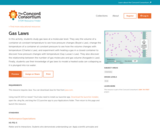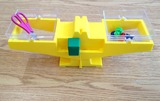
Matching Representations of Linear Functions Mathematics Instructional Plan
- Subject:
- Mathematics
- Material Type:
- Lesson Plan
- Provider:
- VDOE
- Author:
- VDOE
- Date Added:
- 10/07/2024

Matching Representations of Linear Functions Mathematics Instructional Plan

In this activity, students study gas laws at a molecular level. They vary the volume of a container at constant temperature to see how pressure changes (Boyle's Law), change the temperature of a container at constant pressure to see how the volume changes with temperature (Charles’s Law), and experiment with heating a gas in a closed container to discover how pressure changes with temperature (Gay Lussac's Law). They also discover the relationship between the number of gas molecules and gas volume (Avogadro's Law). Finally, students use their knowledge of gas laws to model a heated soda can collapsing as it is plunged into ice water.

In this unit, students explore the concept of multi-digit division and its applications, such as interpreting a remainder in division word problems and using division to determine the nth term in a repeating shape pattern.
Students developed a foundational understanding of division in Grade 3, when they came to understand division in relation to equal groups, arrays, and area. They developed a variety of strategies to build towards fluency with division within 100, and they applied that knowledge to the context of one- and two-step problems using the four operations. Students also came to understand the distributive property, which underpins the standard algorithm for division.
Just as at the beginning of the previous unit when students expanded their understanding of multiplication beyond Grade 3 understanding to include multiplicative comparison word problems, this unit starts off with the added complexity of division problems with remainders (4.OA.3). This is likely familiar to students from their own real-world experiences of trying to split quantities evenly, and thus the focus is on interpretation of those remainders in the context of various problems. Next, students focus on extending their procedural skill with division to include up to four-digit dividends with one-digit divisors (4.NBT.6), representing these cases with base ten blocks, the area model, partial quotients, and finally the standard algorithm, making connections between all representations as they go. The use of the area model serves to help students conceptually understand division, and as a connection to their work with area and perimeter (4.MD.3), a supporting cluster standard. Lastly, armed with a deep understanding of all four operations spanned over the last three units, students solve multi-step problems involving addition, subtraction, multiplication, and division, including their new problem situations such as multiplicative comparison and interpreting remainders (4.OA.3). They also explore number and shape patterns, using the four operations to draw conclusions about them (4.OA.5).
Throughout the unit, students are engaging with the mathematical practices in various ways. For example, students are seeing and making use of structure (MP.7) as they “decompos[e] the dividend into like base-ten units and find the quotient unit by unit” (NBT Progressions, p. 16). Further, "by reasoning repeatedly (MP.8) about the connection between math drawings and written numerical work, students can come to see multiplication and division algorithms as abbreviations or summaries of their reasoning about quantities” (NBT Progression, p. 14). Lastly, as students solve multi-step word problems involving addition, subtraction, and multiplication, they are modeling with mathematics (MP.4).
While students are encouraged throughout the unit to use models when appropriate to solve problems, their in-depth experience with the place value system and multiple conceptual models and exposure to the division algorithms prepares them for extending these models to two-digit divisors in Grade 5 (5.NBT.6) and to fluency with the division algorithm in Grade 6 (6.NS.2). Every subsequent grade level depends on the understanding of multi-digit division and its algorithms, making this unit an important one for students in Grade 4.

This resource is a remix from Illustrative Mathematics (https://goopenva.org/courses/3-md-how-heavy). This resource encourages student collaboration and allows students to have a mathematical dialogue as express their understanding of units of measure. Teachers can use objects found around the house to demonstrate mathematics in the real world. I like how this resource adds flexibility in instruction, as it allows teachers to creatively add diverse manipulatives or real-life items on the balance scale. This activity scaffolds the learning process allowing students an opportunity to experience active hands-on learning to strengthen their understanding of mathematical concepts, which provides a diverse learning experience. This resource is a valuable part of building background when introducing units of measure or equations in the early elementary years of mathematics education as it provides students a concrete example of building an equation with concrete objects. Suggested Modification - A student recording sheet with illustrations has been added to the resource to allow all different types of learner to learn from a concrete idea to strengthen conceptual learning about building an equation.

Determine SlopeMathematics Instructional Plans (MIPs) help teachers align instruction with the Mathematics Standards of Learning (SOL) by providing examples of how the knowledge, skills and processes found in the SOL and curriculum framework can be presented to students in the classroom.

8.16e Matching Representations Co-Teaching MIP